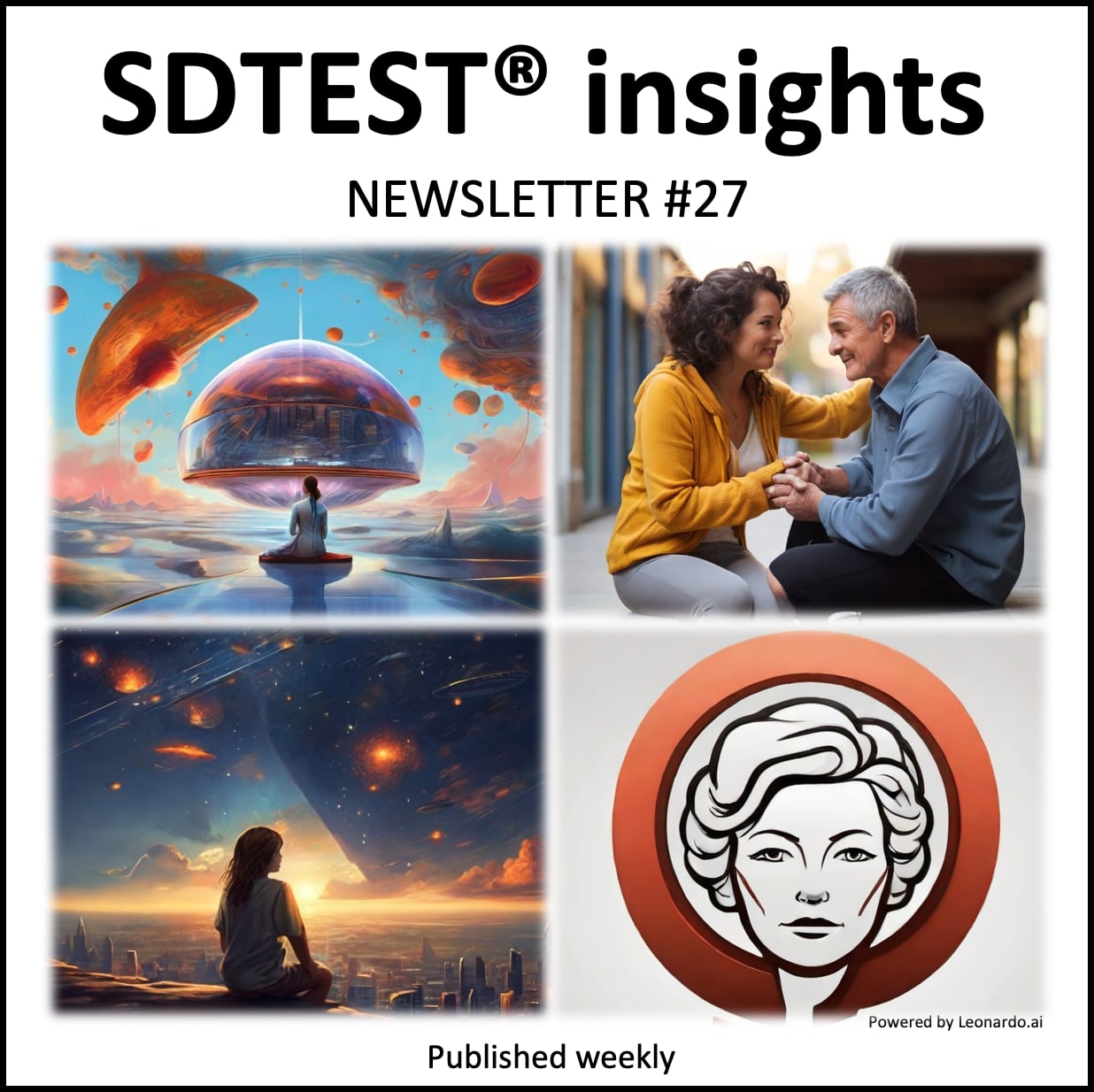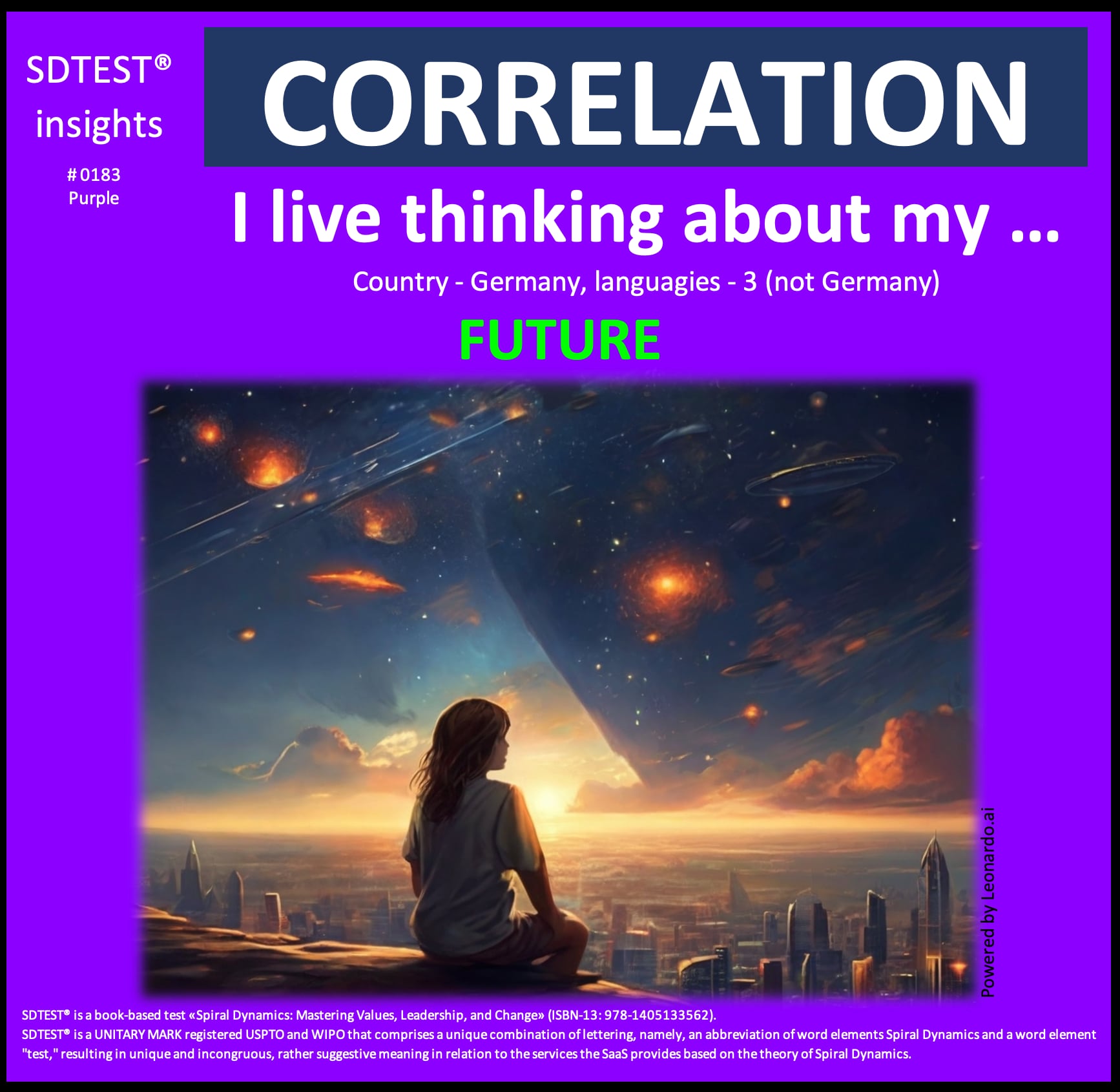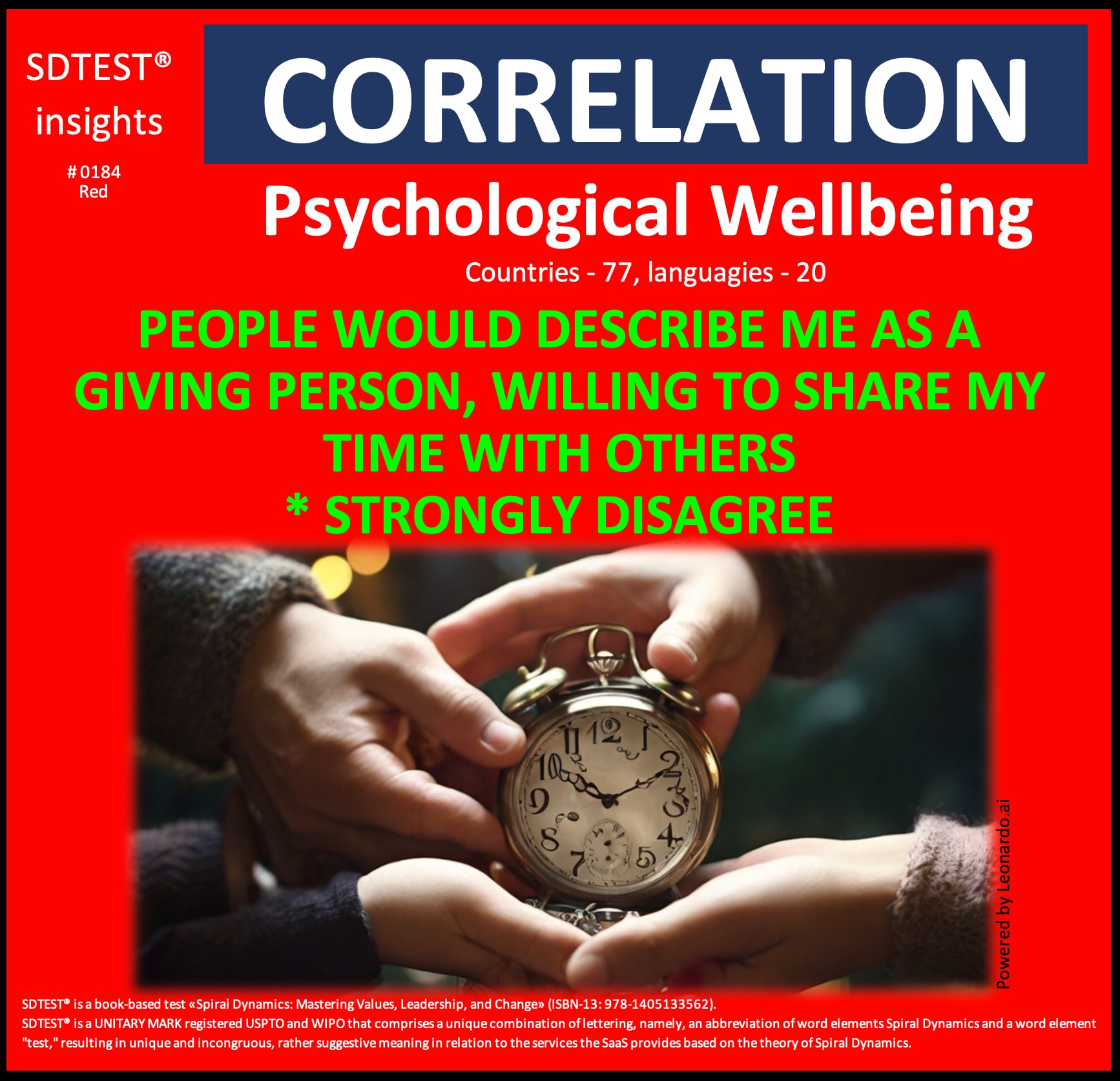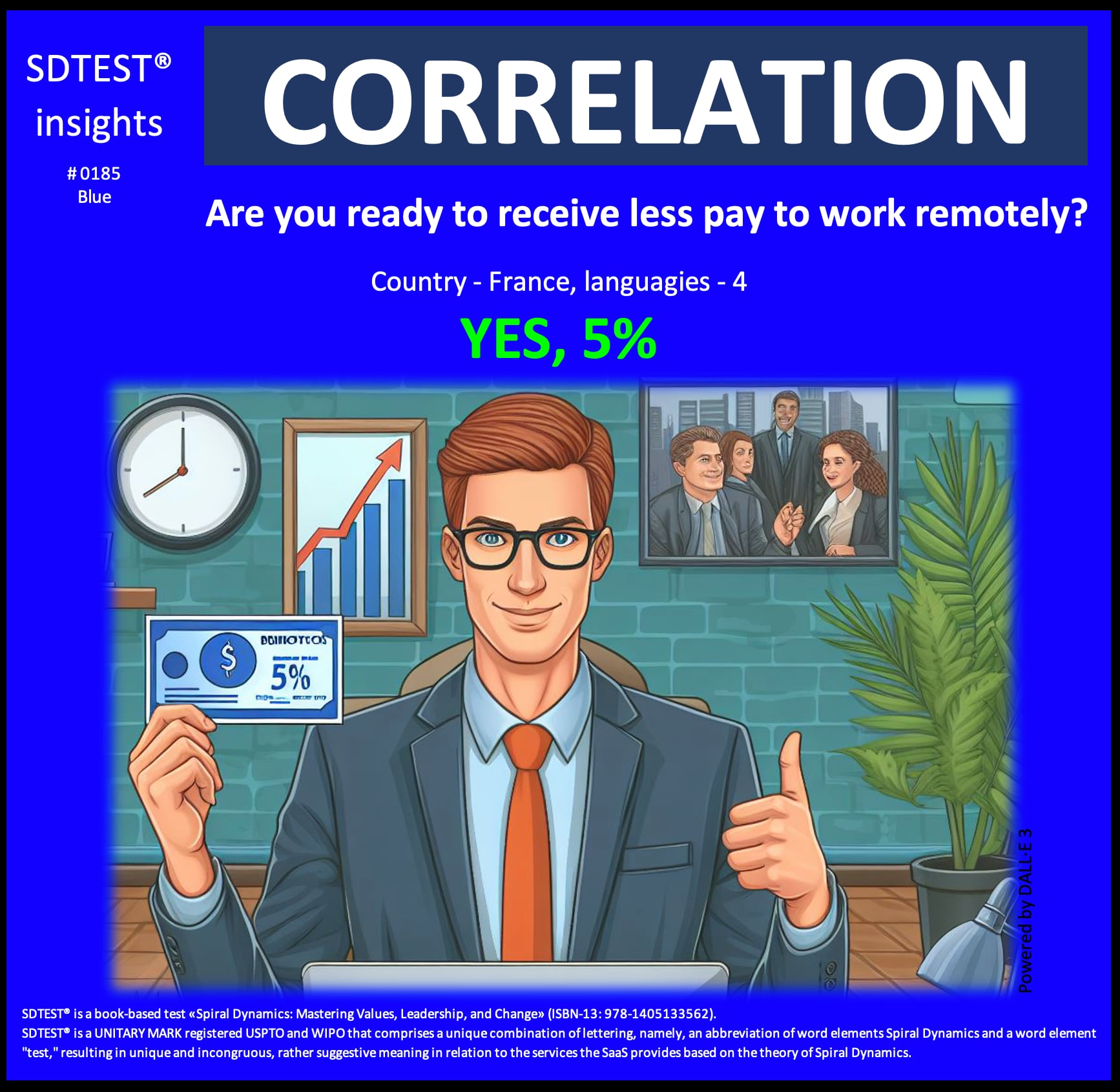This positive correlation of 0.3410 between willingness to accept a 5% pay cut for remote work and the Blue stage in France among respondents who speak four languages, including French, offers intriguing insights:
Organizations operating within the Blue mindset might interpret this correlation as:
Individuals aligned with the Blue value system, whether native French or multilingual residents, might interpret this correlation as:
This correlation, viewed through the Blue lens in the French context, suggests a strong alignment between traditional French work values and the willingness to accept reduced compensation for remote work, even among multilingual and potentially multicultural employees. This implies that the blue value system in France has a powerful influence that transcends linguistic and cultural differences.
From this perspective, the correlation invites us to explore how a diverse workforce adopts and internalizes French work culture and its traditional values. It prompts us to ask: How does the solid Blue value system in France shape the attitudes of both native and non-native workers? What role does cultural integration play in employees' willingness to accept financial sacrifices?
Ultimately, this correlation speaks to the enduring power of French organizational culture and its ability to instill Blue values across a diverse workforce. It reminds us that in the Blue worldview, adherence to established norms and loyalty to organizational principles can outweigh personal financial considerations, even for those who may have been exposed to different cultural systems.
This interpretation raises essential questions about the interplay between cultural adaptation, workplace expectations, and personal sacrifice in an increasingly globalized French workforce. It challenges us to consider how French organizations can maintain their traditional values while respecting and leveraging the diverse perspectives of multilingual and multicultural employees.
This negative correlation of -0.3347 between support for ageism working groups and the Orange stage in the USA offers intriguing insights when viewed through the lens of the Orange value system:
Organizational Perspective:
Organizations operating within the Orange mindset might interpret this correlation as:
- Evidence that focusing on ageism could potentially hinder efficiency and productivity.
- Validation that merit-based systems naturally address age-related concerns without dedicated resources.
- A signal to prioritize performance metrics over demographic considerations.
These organizations might respond by:
- Implementing age-blind recruitment and promotion processes based solely on quantifiable skills and achievements.
- Investing in technology and training to enhance productivity across all age groups rather than addressing ageism directly.
- Developing data-driven performance evaluation systems that objectively measure output regardless of age.
Team Perspective:
Teams operating from an Orange mindset might approach this correlation by:
- Viewing it as justification for focusing on results rather than age-related discussions.
- Interpreting it as a call to emphasize skill development and innovation over demographic considerations.
- Seeing it as an opportunity to promote a more competitive, achievement-oriented team culture.
These teams might respond by:
- Implementing project management tools that highlight individual contributions based on measurable outcomes.
- Encouraging continuous learning and adaptation to new technologies across all team members.
- Fostering a culture of healthy competition that rewards innovation and efficiency regardless of age.
Individual Perspective:
Individuals aligned with the Orange value system might interpret this correlation as:
- Confirmation that personal achievement should take precedence over group identity factors like age.
- An opportunity to focus on self-improvement and skill acquisition rather than age-related advocacy.
- Validation of the belief that success is determined by individual merit and effort, not demographic factors.
These individuals might respond by:
- Investing in personal development and staying current with industry trends to maintain competitiveness.
- Seeking out challenging projects that showcase their skills and drive for success.
- Advocating for performance-based recognition systems within their organizations.
This correlation, viewed through the Orange lens, suggests a potential conflict between addressing ageism through dedicated working groups and the Orange value system's focus on individual merit, efficiency, and measurable outcomes. It implies that those most aligned with Orange values may see less value in explicitly addressing age-related concerns in the workplace.
From this perspective, the correlation invites us to explore the tension between diversity initiatives and performance-driven cultures. It prompts us to ask: How can organizations balance the pursuit of efficiency and innovation with the need to address potential age-related biases? What role do data and analytics play in understanding and addressing ageism without compromising productivity?
Ultimately, this correlation speaks to the complex interplay between organizational performance, individual achievement, and demographic considerations in modern workplaces. It challenges us to consider how Orange-oriented organizations can foster environments that maximize individual potential across all age groups without resorting to what might be perceived as less efficient, group-identity-focused initiatives.
This interpretation also raises important questions about the potential blind spots in a merit-based approach to workplace dynamics. It invites us to explore innovative, data-driven methods for addressing ageism that align with Orange values of efficiency and measurable outcomes, potentially uncovering new ways to enhance equity and productivity in the workplace.
In our analysis of the poll "Ageism in Life," we found an intriguing positive correlation that warrants closer examination:
0.3369 between the Female and the Green stage (USA, two languages).
The critical value of the correlation coefficient for a normal distribution, by William Sealy Gosset (Student) r = 0.2843. This positive correlation of 0.3369 meets the reliability criteria but does not necessarily imply causation.
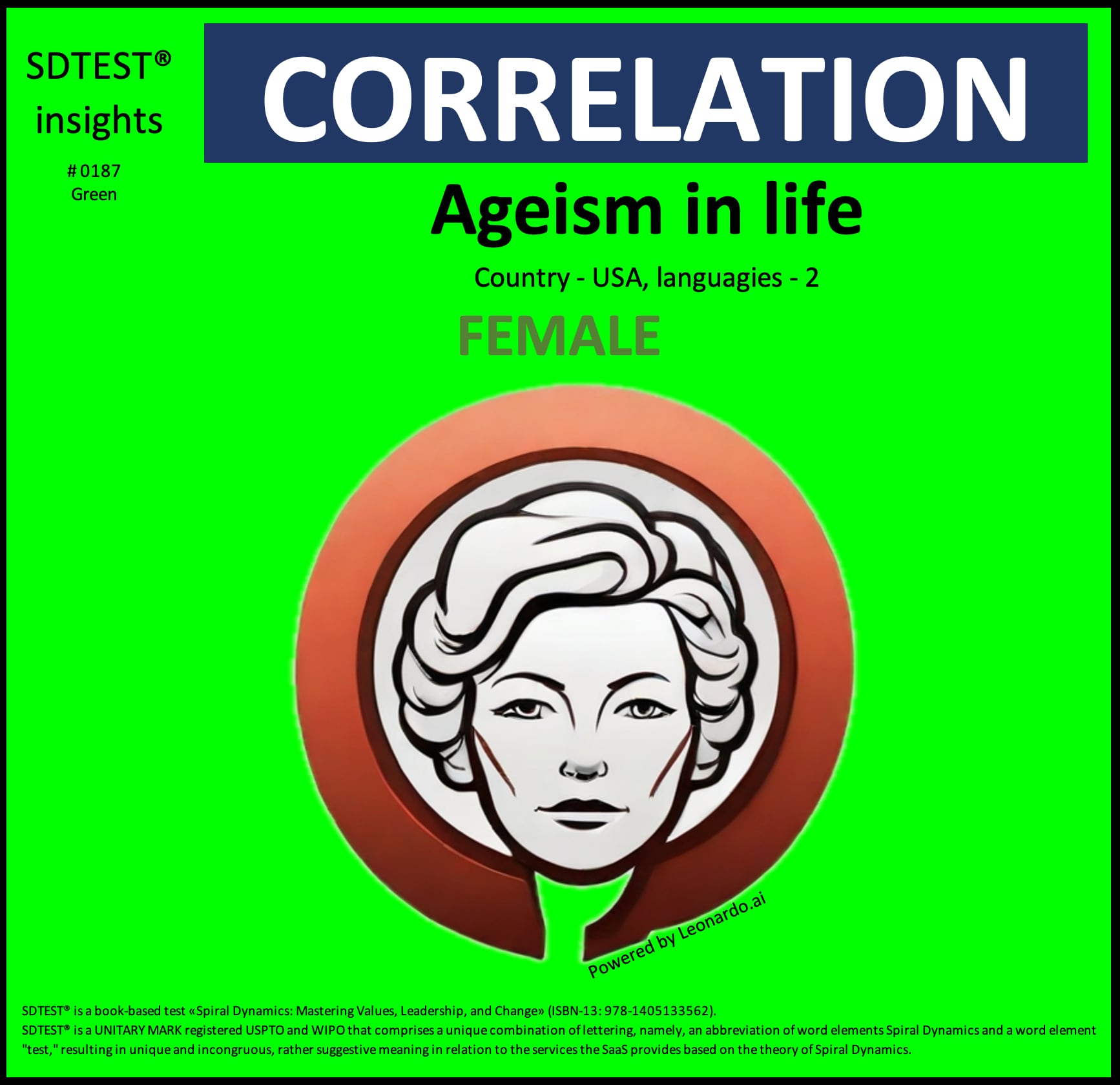
This positive correlation of 0.3369 between female respondents and the Green stage in the USA, in the context of ageism in life, offers intriguing insights when viewed through the lens of the Green value system:
Organizational Perspective:
Organizations operating within the Green mindset might interpret this correlation as:
- An opportunity to address ageism in society through a more holistic, inclusive approach that recognizes the intersectionality of age and gender.
- Evidence supporting the need for community-based initiatives that combat age discrimination, mainly as it affects women throughout their lives.
- A call to action for developing intergenerational programs that foster understanding and mutual support across age groups.
These organizations might respond by:
- Initiating community dialogue sessions that explore how ageism affects different genders throughout the lifespan.
- Developing educational programs highlighting the value of wisdom and experience across all ages and genders.
- Creating partnerships with women-led organizations to address ageism from a more holistic, Green perspective.
Team Perspective:
Teams operating from a Green mindset might approach this correlation by:
- Viewing it as an affirmation of the need for diverse, multi-generational teams in addressing societal issues like ageism.
- Interpreting it as a call to foster more empathetic, inclusive team environments that value members of all ages.
- Seeing it as an opportunity to leverage female perspectives in developing more comprehensive approaches to combating ageism in society.
These teams might respond by:
- Implementing storytelling sessions where team members share personal experiences with ageism across different life stages.
- Encouraging projects that bring together people of various ages to address community needs, fostering intergenerational understanding.
- Developing awareness campaigns that challenge age-related stereotypes, particularly those affecting women throughout their lives.
Individual Perspective:
Individuals aligned with the Green value system might interpret this correlation as:
- Personal validation of their holistic view on aging and the life course.
- It is An opportunity to challenge their internalized ageist beliefs and promote age-inclusive attitudes in their communities.
- A call to action to support and advocate for people of all ages, recognizing the unique challenges women face across the lifespan.
These individuals might respond by:
- Engaging in personal reflection on their own age-related biases and how these intersect with gender.
- Seeking out intergenerational friendships and mentorship opportunities.
- Advocating for policies and practices that support age inclusivity in their communities, focusing on issues affecting women.
This correlation, viewed through the Green lens, suggests a strong alignment between female perspectives and a more holistic, empathetic approach to aging and ageism in society. It implies that women in the USA may be more inclined to recognize and address ageism's complex, systemic nature throughout life.
From this perspective, the correlation invites us to explore how gender influences perceptions of aging and experiences of ageism. It prompts us to ask: How can we leverage this apparent affinity between women and Green values to create more age-inclusive communities? What insights can we gain from female perspectives on aging to foster more supportive, interconnected societies for people of all ages?
Ultimately, this correlation speaks to the potential for female leadership and perspectives to play a crucial role in addressing ageism through a Green value lens emphasizing empathy, inclusivity, and the interconnectedness of all life stages. It challenges us to consider how to create a society that values and supports individuals of all ages, recognizing each life stage's unique contributions and needs.
In our analysis of the poll "Gender difference in building self-confidence" (by IFD Allensbach), we found an intriguing negative correlation that warrants closer examination:
-0.4784 between the Relationships with parents and the Yellow stage (USA, three languages).
The critical value of the correlation coefficient for a normal distribution, by William Sealy Gosset (Student) r = 0.3437. This negative correlation of -0.4784 meets the reliability criteria but does not necessarily imply causation.
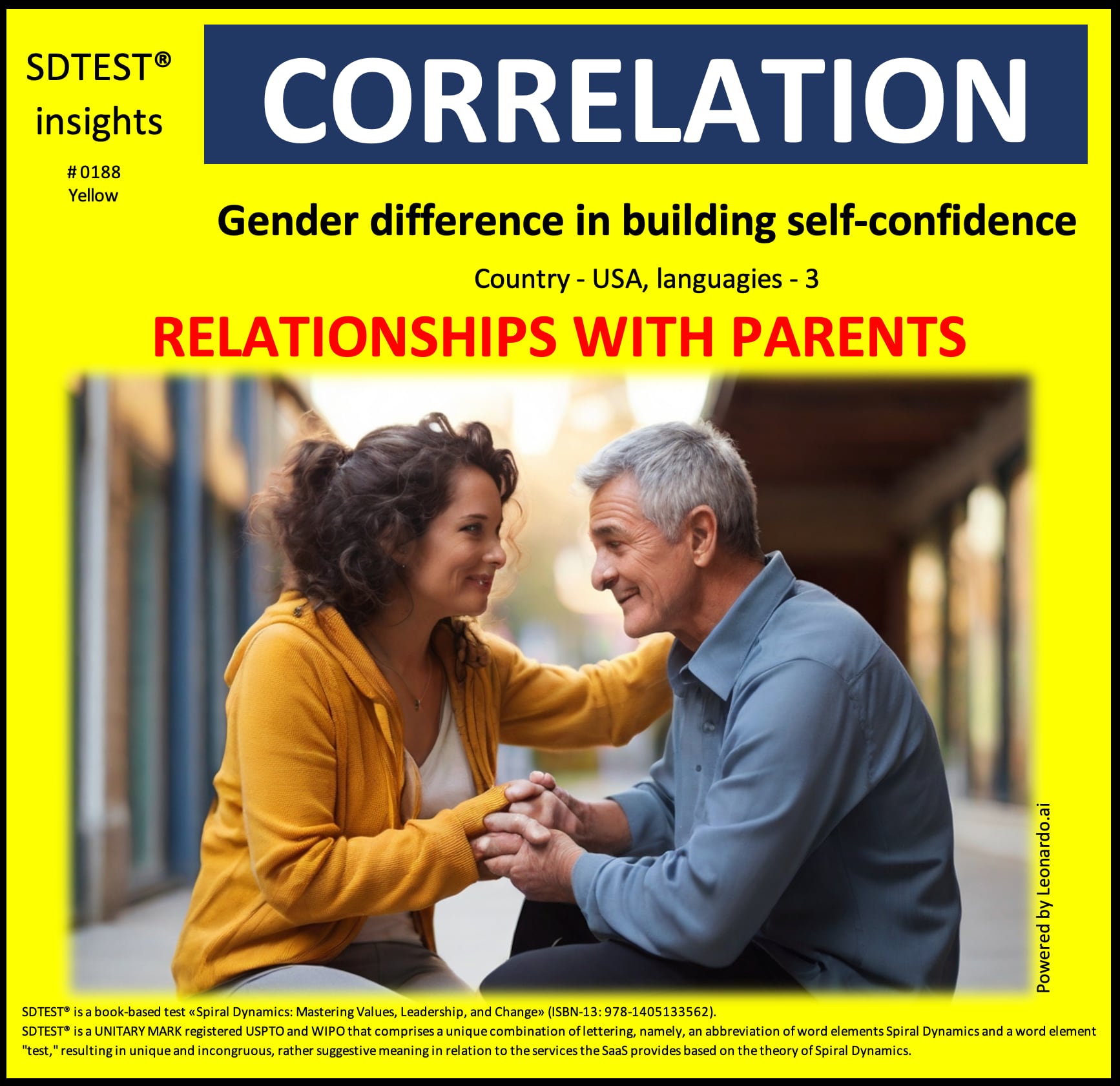
This negative correlation of -0.4784 between "Relationships with parents" and the Yellow stage in the USA offers fascinating insights when viewed through the lens of the Yellow value system:
Organizational Perspective:
Companies operating within the Yellow mindset might interpret this correlation as:
- An indication that traditional family dynamics may not be the primary source of self-confidence for those with more integrative worldviews.
- An opportunity to explore diverse personal growth and development sources beyond conventional relationships.
- A challenge to create organizational cultures that foster self-confidence through multifaceted, systemic approaches.
These organizations might respond by:
- Implementing holistic personal development programs that recognize the complexity of self-confidence building.
- Creating mentorship networks that transcend traditional hierarchies and draw from diverse life experiences.
- Developing flexible support systems that adapt to individual needs and unique personal growth trajectories.
Team Perspective:
Teams operating from a Yellow mindset might approach this correlation by:
- Viewing it as an invitation to explore non-traditional sources of team cohesion and individual empowerment.
- Interpreting it as a call to create more fluid, adaptive team structures supporting diverse self-confidence paths.
- Seeing it as an opportunity to leverage the team's collective wisdom in nurturing each member's unique developmental journey.
These teams might respond by:
- Implementing peer-to-peer coaching systems that draw on team members' diverse strengths and experiences.
- Encouraging exploration of how different cultural and personal backgrounds influence self-confidence building.
- Developing team projects that challenge members to grow beyond their comfort zones in supportive, collaborative environments.
Individual Perspective:
Individuals aligned with the Yellow value system might interpret this correlation as:
- Validation of their journey towards self-actualization beyond traditional familial expectations.
- An opportunity to integrate diverse life experiences and relationships into a more holistic sense of self.
- A call to transcend conventional notions of self-confidence and explore more nuanced, contextual understandings of personal growth.
These individuals might respond by:
- Engaging in deep self-reflection to understand their unique path to self-confidence.
- Seeking diverse mentors and role models from various life stages and backgrounds.
- Exploring how their self-confidence interacts with and influences complex systems around them.
This correlation, viewed through the Yellow lens, suggests that individuals at this stage may derive self-confidence from sources beyond traditional parent-child relationships. It implies a more complex, multifaceted approach to personal development that integrates various life experiences and perspectives.
From this perspective, the correlation invites us to explore the evolving nature of self-confidence in an increasingly interconnected and complex world. It prompts us to ask: How can we foster self-confidence in ways that acknowledge the diverse, non-linear paths of personal growth? What role do systemic understanding and integrating multiple perspectives play in building robust, adaptive self-confidence?
Ultimately, this correlation speaks to the potential for a more nuanced, holistic approach to personal development that transcends traditional relational models. It challenges us to consider how self-confidence can be nurtured through a deep understanding of complex systems, integration of diverse experiences, and an ability to navigate multiple perspectives.
In our analysis of the poll "XING's culture assessment" (Strategic direction. Imagine a great employer - which aspects do you like the most?), we found an intriguing positive correlation that warrants closer examination:
0.2757 between the Company is visionary and the Turquoise stage.
The critical value of the correlation coefficient for a normal distribution, by William Sealy Gosset (Student) r = 0.1722. This positive correlation of 0.2757 meets the reliability criteria but does not necessarily imply causation.
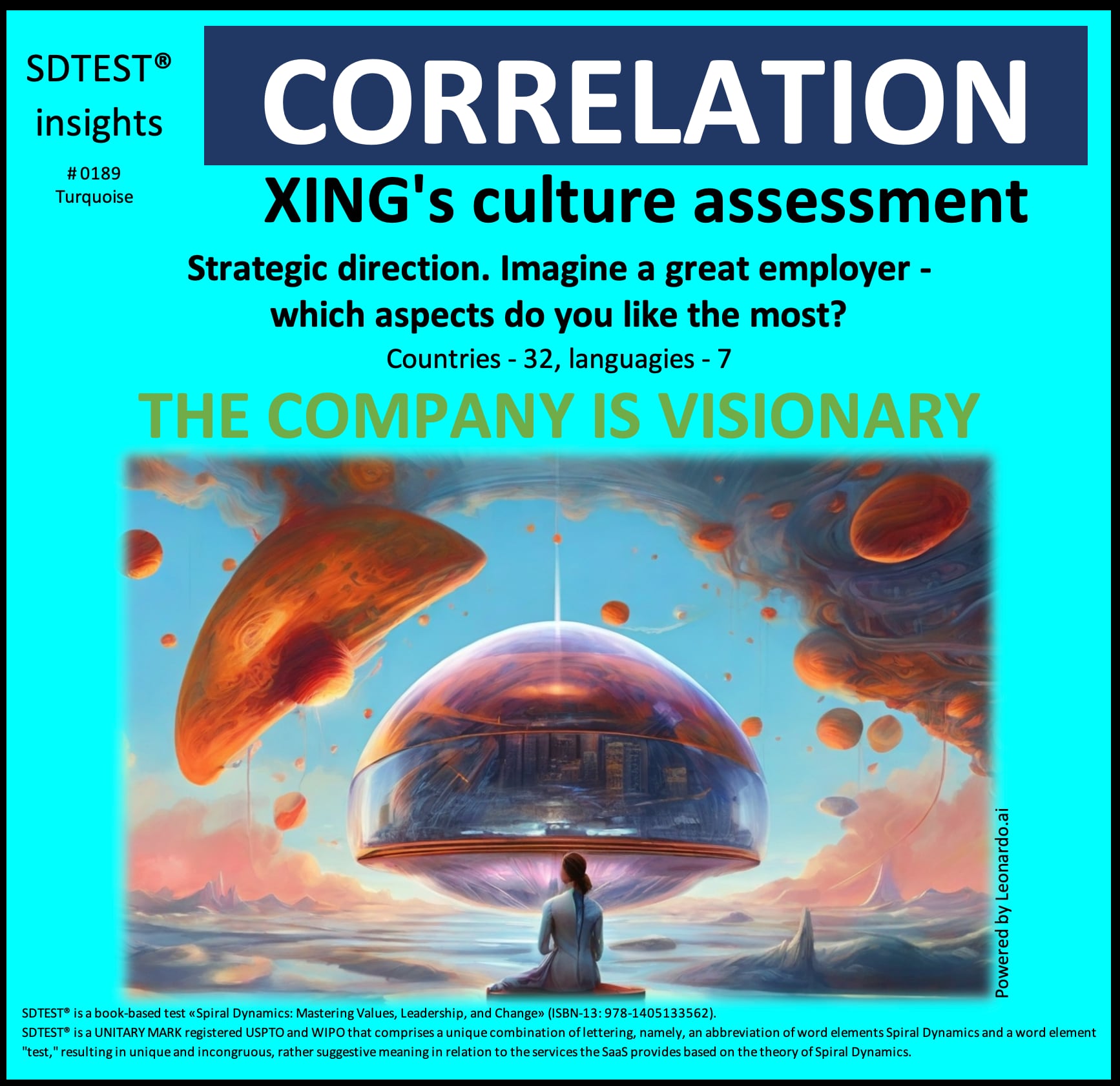
This positive correlation of 0.2757 between valuing a visionary company and the Turquoise stage offers profound insights when viewed through the lens of the Turquoise value system:
Organizational Perspective:
Companies operating within the Turquoise mindset might interpret this correlation as:
- Affirm their holistic, long-term vision encompassing planetary well-being alongside business success.
- Validation of their efforts to integrate diverse perspectives and systems thinking into their strategic direction.
- Evidence that their commitment to sustainability and global harmony resonates with an evolved consciousness.
These organizations might respond by:
- Developing visionary strategies that address complex global challenges while fostering business growth.
- Implementing decision-making processes that consider long-term impacts on all interconnected systems.
- Creating collaborative platforms that bring together diverse stakeholders to co-create sustainable futures.
Team Perspective:
Teams operating from a Turquoise mindset might approach this correlation by:
- Viewing it as an invitation to deepen their collective visioning practices, incorporating cosmic and ecological awareness.
- Interpreting it as a call to foster team environments that nurture individual and collective evolution.
- Seeing it as an opportunity to align team goals with broader universal harmonies and rhythms.
These teams might respond by:
- Engaging in regular contemplative practices to attune to larger patterns and potentials.
- Developing projects that synergistically address multiple dimensions of planetary and human well-being.
- Cultivating a team culture that celebrates diverse expressions of consciousness and ways of knowing.
Individual Perspective:
Individuals aligned with the Turquoise value system might interpret this correlation as:
- Personal validation of their attraction to organizations that embody holistic, visionary thinking.
- An opportunity to contribute their unique insights to shaping expansive, interconnected organizational visions.
- A call to deepen their own visionary capacities and spiritual connection to universal consciousness.
These individuals might respond by:
- Seeking roles that allow them to influence organizational vision from a Turquoise perspective.
- Engaging in practices that enhance their ability to perceive and integrate complex systemic relationships.
- Actively co-creating organizational cultures that honor the sacred in all aspects of work and life.
This correlation, viewed through the Turquoise lens, suggests a profound alignment between advanced stages of consciousness development and the appreciation for visionary organizational thinking. It implies that as individuals evolve towards more integrative, holistic worldviews, they increasingly resonate with companies that embody far-reaching, transformative visions.
From this perspective, the correlation invites us to explore the evolving nature of organizational vision in an interconnected, rapidly changing world. It prompts us to ask: How can companies cultivate truly holistic, planet-centric visions that catalyze collective evolution? What role does individual consciousness development play in shaping and responding to organizational visions?
Ultimately, this correlation speaks to the emerging potential for organizations to serve as vehicles for planetary healing and collective consciousness evolution. It challenges us to reimagine the very purpose of business, moving beyond profit and even sustainability to envision companies as living systems that contribute to the harmonious unfolding of cosmic intelligence.

